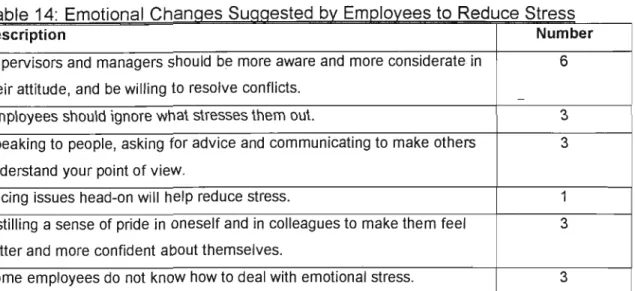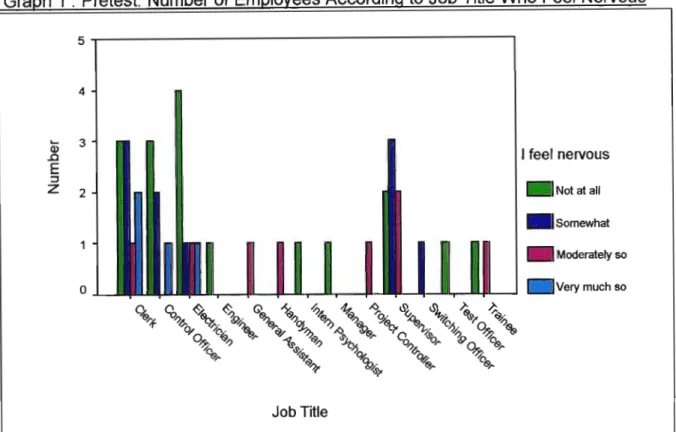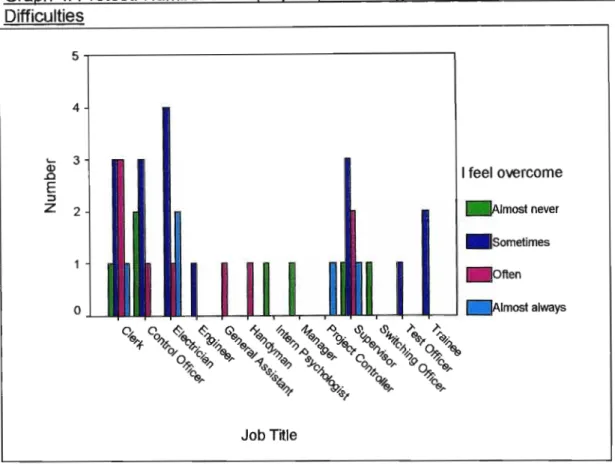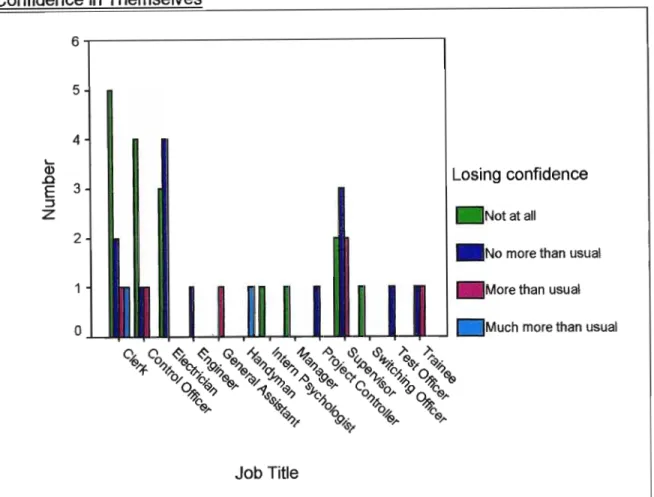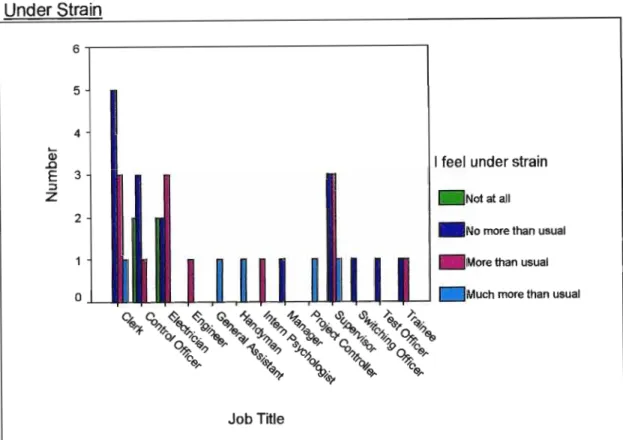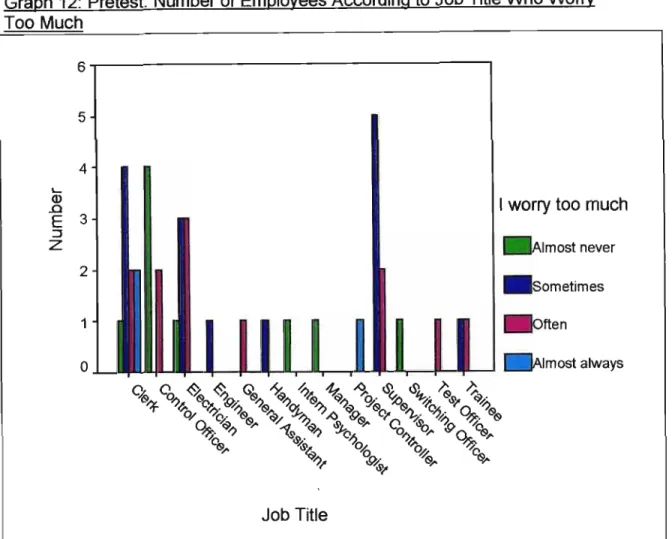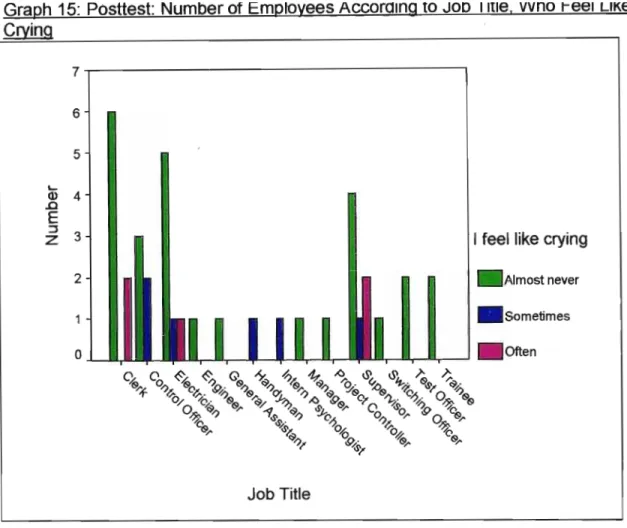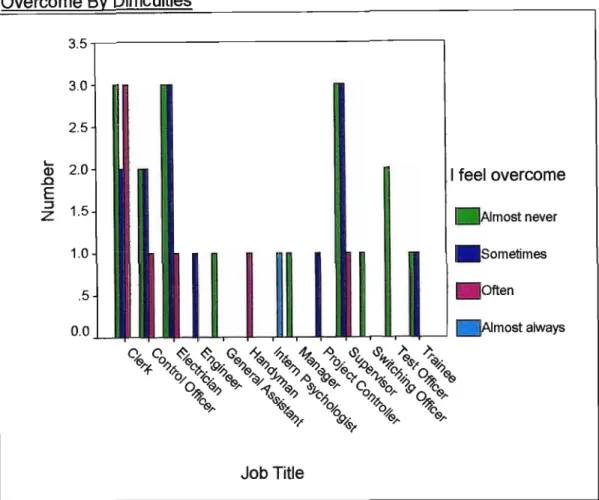Total percentage of employees who feel happy 110 Table 21: Pre-test: Score, Row percentage, Column percentage and. Total percentage of employees who feel pleasant 115 Table 23: Pre-test: Score, Row percentage, Column percentage and. Total percentage of employees who feel under pressure 117 Table 24: Pre-test: Score, Row percentage, Column percentage and.
Total percentage of employees who get tired quickly 121 Table 26: Pretest: Number, row percentage, column percentage and. Total percentage of employees who feel dissatisfied 123 Table 27: Pretest: Number, row percentage, column percentage and. Total percentage of employees who feel tense 143 Table 37: Post-test: Number, row percentage, column percentage and.
Total percentage of employees who tire quickly 145 Table 38: Posttest: Count, Row Percentage, Column Percentage and. Total Percentage of Employees Feeling Dissatisfied 147 Table 39: Posttest: Count, Row Percentage, Column Percentage and.
List of Abbreviations
Abstract
Chapter One
Introduction
This research is conducted to determine whether Durban Metro Electricity understands the causes and effects of stress among its employees. Therefore, the research will determine whether the strategy implemented by Durban Metro Electricity is successful. The stress levels of Durban Metro Electricity employees will decrease when they participate in a stress management program.
Durban Metro Electricity's policies are determined by the City Council and operates under the Electricity Act 1987. Durban Metro Electricity's mission is to provide services that meet the community's electricity needs, including public lighting, while maintaining sound principles of business. It purchases approximately six percent of the total power generated by Eskom (Durban Metro Annual Electricity Report.
According to Durban Metro Electricity's annual report, the North, Central and South distribution regions all have planning departments, customer service departments, construction departments, maintenance departments and operations departments. The Human Resources Department provides a range of services to other departments of Durban Metro Electricity and consists of the following sub-departments.
Chapter Two Literature Review
The consequences of the process (whether trust and mastery or maladjustment) become apparent over time. However, when an individual suffers from anxiety or depression, then stress can be described as the response or outcome of the stress process. Stress can be perceived as the result of the stress process, that is, what the individual suffers from.
A change in emphasis in the stress process from the nature of the threat to l. Stress occurs only when a person's abilities do not match the demands of the job. Fatigue increases anxiety as well as reduces an individual's ability to cope with the problems they face.
The appearance of each type of stress depends on the perception of the situation by the individual. The purpose of the research being conducted is to identify the sources and manifestations of stress. It is therefore important to consider some of the coping methods, to understand how they are introduced and implemented in the stress management program.
1 Rational thinking helps you look at the objective reality of the situation I object to [2J rational thinking leads you to protect your life (ie: reduce stress).
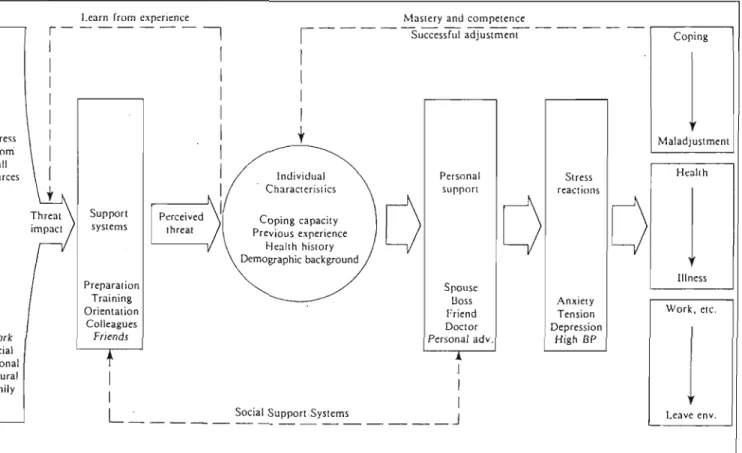
Chapter Three
The aim of the research is to access the stress level and coping skills of employees before and after the stress management program. One of the most appropriate ways to obtain such data would be to use a quantitatively assessed State and Trait Anxiety Inventory and General Health Questionnaire in addition to a qualitative general information questionnaire. Bryman and Cramer (1990) emphasize the importance of quantitative data, as their analysis enables the identification of erroneous conclusions or potentially biased manipulation of information that can occur in qualitative data analysis.
In addition, because the research design is that of surveys, quantitative data analysis does not allow the researcher to manipulate any of the relevant variables, and data related to all variables are collected simultaneously. If the analysis of the data shows that a hypothesis is confirmed, this result can be fed back into the theory. This is related to the fact that one of the main goals of quantitative research is the
The presence of the researcher will affect the data as the people providing it may want to tell the researcher what they think he wants to know. In addition, the level of formulation should be consistent with the educational level of the respondents. The twenty-item version used in the research is a shortened version of the sixty-item version, but its own.
However, the causal effects of the test stimulus (the stress management program) ensure that the posttest results differ from the pretest. Nevertheless, the posttest, which is a repetition of the pretest, could represent a measure of test–retest reliability. It will also try to determine whether. program in any way to reduce stress levels and increase coping skills.
There are three main issues to be covered in the critique:. i) The sample of research conducted is specific to Durban Metro Electricity. therefore, any generalizations or conclusions drawn from the results can only be made in relation to Durban Metro Electricity itself. The pre-test was administered on the morning of the first day of the course. A limitation may be that three weeks is too short a time to assess the impact of the stress management course on DME employees.
Chapter Four
Presentation of Results
One clerk each, an electrician, a general assistant, a foreman, a project supervisor and an intern all feel moderately nervous. One each of engineers, foremen, managers, project controllers, testers and interns also stated that they sometimes feel blue. In addition, each of the general assistants, foremen, project controllers, testers and interns feels happy at times.
Each of the clerks, control officers, general assistants and trainees all feel that they are losing confidence in themselves more than usual. Six clerks, four supervisors, two electricians and a trainee psychologist, manager, testing officers and trainees all feel a bit tense. The graph above shows that four clerks and one of the control officers, artisans and supervisors find that they hardly tire quickly.
Three inspectors and one clerk, trainee psychologist, manager and supervisor each indicate that they do not feel unhappy at all. This is in addition to three electricians, and one general assistant, test officer and trainee each. In addition, two clerks and one control officer, electrician and trainee psychologist feel very nervous.
One of the electricians, general assistants, project controllers, switching officers and interns also claims to almost never feel down. In addition, each of the engineers, general assistants, managers, project controllers, switching officers and interns has the feeling that they do not lose confidence in themselves at all. The employees who are moderately stressed include two inspectors and one electrician and switching officer each.
Moreover, two inspectors, electricians, supervisors and testing officials claim the same thing. In addition, four supervisors and one handyman, manager, liaison officer and trainee each also indicate that they get tired quickly. The same applies to the three electricians and one each of the managers, project controllers and interns.
The same applies to three control officers, two electricians and one each of engineers, general assistants, handymen and public relations officers. Three clerks, two control officers and one each of electricians, engineers, project controllers and apprentices all say that sometimes they worry too much.
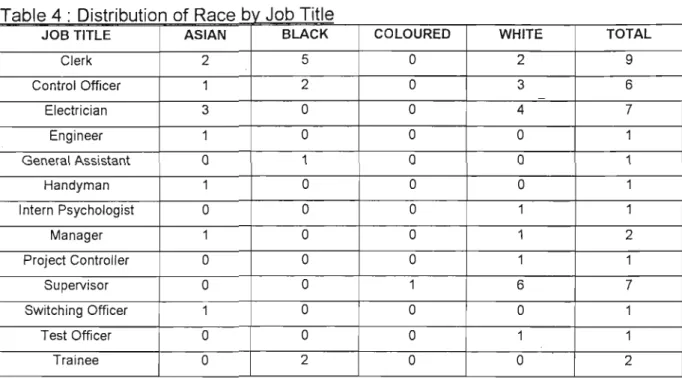
Chapter Five
However, it is not enough to have only one person or one level of organizational learning. Therefore, the competence of employees can be improved, along with their productivity and quality. Not having a career path can be stressful for an employee, as they may feel that they.
So there is not much that can be done about the anxiety and stress of such employees. In the physical sense, stress can be seen as a physiological response of an individual to environmental changes. The t-test score of 0.27 of this variable shows a significant reduction in the number of employees who feel like crying.
The variable "I feel happy" can also be linked to the emotional effects of stress. The measure of feelings of happiness can also be used to determine the measure of stress. The variable "I feel I'm losing confidence in myself" can be associated with the emotional effects of stress.
In addition, it can be related to problems with staff attitudes or general problems in communication with staff and colleagues. It is a comprehensive variable that can be used to analyze a variety of different stressors. This is another comprehensive variable that can be used to analyze and explain most perceived stressors.
The variable "I get tired quickly" can be directly related to physical effects of stress as well as cognitive effects. However, the t-test score of 0.183 shows no significant difference in the scores between the pre- and post-test. The variable "I worry too much" can be linked to issues of safety at work, stressful work tasks, management problems and emotional effects of stress.
